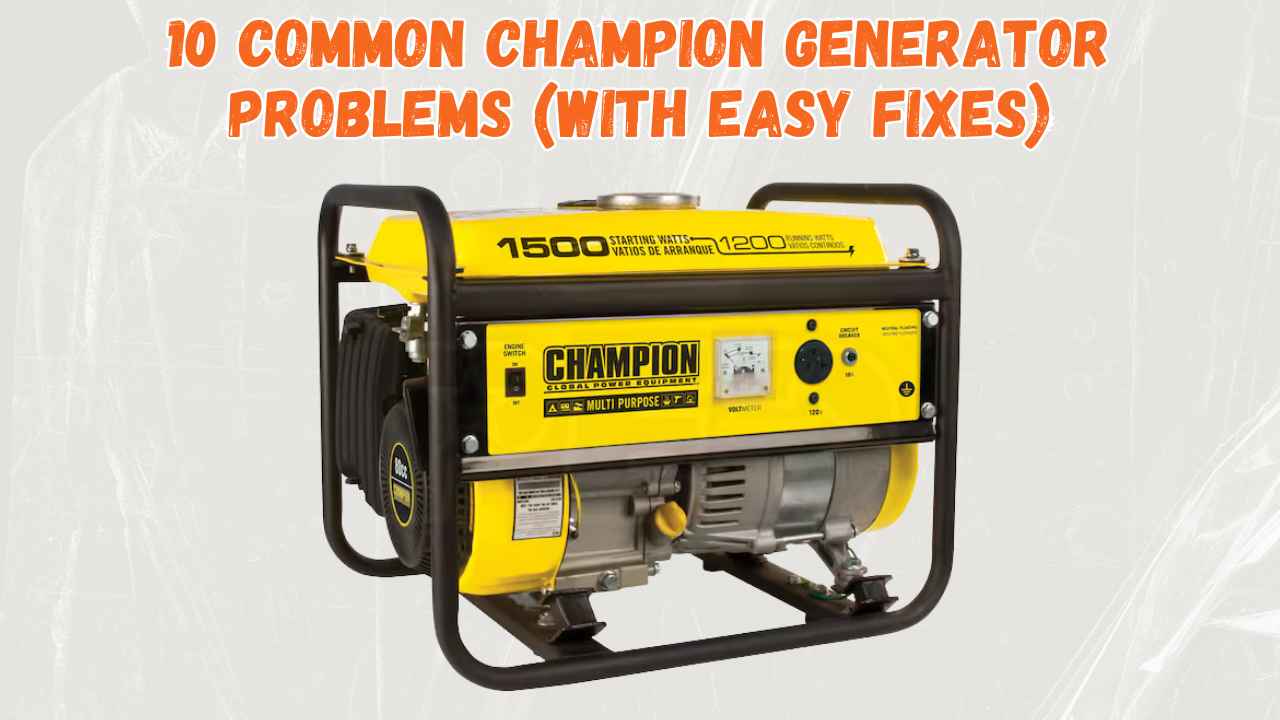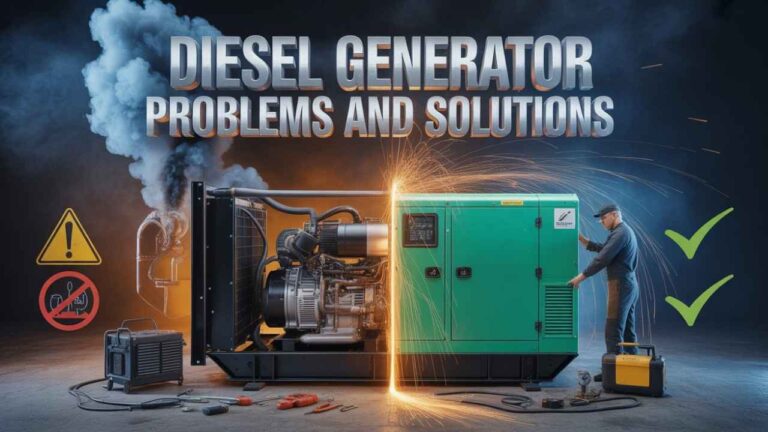Champion Generator Problems can disrupt your projects and daily activities, but most issues are easier to fix than they seem.
From starting troubles to inconsistent power output, understanding these common challenges can save you time and money.
This guide breaks down 10 frequent problems and provides simple solutions to get your generator running smoothly again.
Champion Generator Problems (Short Overview)
Champion generators can face issues like not starting, low power output, or sudden shutdowns.
These problems are often caused by simple things like old fuel, clogged filters, or loose connections.
Check and fix these first to keep your generator working reliably and efficiently!
Read 10 Common Problems With Fixes In Easy Ways…

1. Generator Won’t Start
Causes:
The most common reason is stale or insufficient fuel.
Old gasoline can clog the carburetor and fuel lines.
Other potential causes include a low oil level, a dislodged or faulty spark plug, a clogged air filter, or an engaged choke that should be open.
Fixes:
First, check your fuel and oil levels. If the fuel is more than a month old, drain it and replace it with fresh gasoline.
Ensure the oil is filled to the correct level. Next, inspect the spark plug to make sure it’s clean and properly connected.
Finally, check the air filter for dirt and debris, cleaning or replacing it if necessary.
Make sure the choke is in the correct position for starting (usually closed) and then moved to the open position once the engine warms up.
2. Generator Starts Then Stops
Causes:
This problem is often caused by a clogged fuel filter, a blocked fuel line, or a dirty carburetor.
An obstructed air filter can also restrict airflow, causing the engine to stall.
Additionally, the low-oil sensor might be malfunctioning or triggered by a genuinely low oil level, automatically shutting off the engine to prevent damage.
Fixes:
Start by checking the oil level and adding more if it’s low. Inspect and clean the air filter.
If the issue persists, you may need to clean the carburetor. This involves removing it, spraying it with carburetor cleaner, and ensuring all jets are clear.
Also, check the fuel filter and replace it if it appears dirty or clogged.
3. Generator Overloads Frequently
Causes:
The primary cause is connecting too many high-wattage devices at once.
Startup wattage, which is the extra power an appliance needs to turn on, can also contribute to an overload.
Faulty appliances that draw more power than they should or a malfunctioning circuit breaker on the generator itself can also be culprits.
Fixes:
Calculate the total wattage of all the devices you want to power. Ensure this number is below your generator’s rated running wattage.
Start your appliances one at a time, beginning with the one that requires the most power.
If the problem continues, test each appliance individually to see if one is faulty and causing the issue.
4. Generator Runs Rough or Surges
Causes:
The most frequent cause is a dirty or clogged carburetor, which disrupts the fuel-to-air ratio.
Stale fuel, a clogged fuel filter, or a dirty spark plug can also lead to rough running.
In some cases, water may have contaminated the fuel, which will cause the engine to sputter and perform poorly.
Fixes:
Begin by draining old fuel and replacing it with a fresh supply. Adding a fuel stabilizer can help prevent future issues.
Clean or replace the air and fuel filters. Inspect the spark plug for wear and clean or replace it as needed.
If these steps don’t resolve the problem, the carburetor likely needs a thorough cleaning.
Read Also:
Kitchenaid spaghetti cutter problems
5. No Power Output
Causes:
This issue is often caused by a tripped circuit breaker, which can be easily reset.
Another common reason is a loss of residual magnetism in the alternator, which is necessary to generate electricity.
A faulty Automatic Voltage Regulator (AVR), worn-out alternator brushes, or damaged wiring can also prevent power output.
Fixes:
First, check the circuit breakers on the generator’s control panel and reset any that have tripped.
If that doesn’t work, you may need to “flash the field” to restore the alternator’s magnetism.
This process involves using a 12V battery to briefly energize the alternator.
If you’re not comfortable with this, or if the issue persists, the AVR or alternator brushes may need professional replacement.
6. Low Power Output or Voltage Drop
Causes:
A common cause is a dirty air filter or a partially clogged carburetor, which prevents the engine from reaching its full RPMs.
The issue could also be electrical, such as a failing Automatic Voltage Regulator (AVR) that is no longer maintaining a stable voltage.
Worn alternator brushes can also contribute to inconsistent power output.
Fixes:
Start with engine maintenance: clean the air filter and carburetor to ensure the engine is running at its best.
Make sure the engine’s RPM is set correctly according to the user manual. If the problem is electrical, the AVR might need to be tested and replaced.
This is often a job best left to a qualified technician.
7. Excessive Fuel Consumption
Causes:
A clogged air filter is a major culprit, as it forces the engine to burn more fuel to compensate for the lack of oxygen.
A carburetor that is improperly adjusted or has a stuck float can also lead to a rich fuel mixture.
Additionally, running the generator under a consistently heavy load will naturally increase fuel consumption.
Fixes:
Inspect and clean or replace the air filter to ensure proper airflow.
Check the carburetor settings and adjust them according to your user manual, or have a technician do it for you.
Also, evaluate your power load; if possible, reduce the number of appliances running simultaneously to ease the strain on the engine.
8. White or Black Smoke from Exhaust
Causes:
Black smoke indicates that the engine is burning too much fuel (running rich).
This is typically caused by a dirty air filter or a malfunctioning choke that is stuck in the closed position.
White or bluish smoke means the engine is burning oil, which could be due to overfilling the crankcase with oil, worn piston rings, or bad valve seals.
Fixes:
For black smoke, check the air filter and clean or replace it. Also, ensure the choke is moving freely and is in the open position when the engine is warm.
For white smoke, first check the oil level and drain any excess.
If the problem persists after correcting the oil level, the engine may have internal wear and require professional service.
9. Fuel Leaking from the Generator
Causes:
Leaks are often caused by cracked or degraded fuel lines, a faulty fuel petcock (shut-off valve), or a damaged carburetor float bowl gasket.
The carburetor float itself might be stuck, causing fuel to overflow.
Gaskets and seals can also dry out and crack over time, especially if the generator is stored for long periods.
Fixes:
Immediately turn off the generator and move it to a well-ventilated area away from ignition sources.
Carefully inspect the fuel lines, petcock, and carburetor to pinpoint the source of the leak. Replace any cracked fuel lines or worn gaskets.
If the carburetor is overflowing, it may need to be disassembled and cleaned, and the float may need to be replaced.
10. Excessive Noise or Vibration
Causes:
Excessive vibration is often caused by the generator being placed on an uneven surface. It can also be due to loose mounting bolts on the engine or alternator.
A sudden increase in noise could mean the muffler is damaged or has come loose. Internal engine problems, such as a worn bearing, could also be the source.
Fixes:
Ensure the generator is on a flat, solid surface. Check and tighten all external bolts, including the engine and alternator mounts.
Inspect the muffler and its heat shields for any loose parts or damage.
If the noise seems to be coming from inside the engine, turn it off immediately and consult a professional technician, as this could indicate a serious internal issue.
FAQs
How often should I change the oil in my Champion generator?
You should change the oil after the first 20-30 hours of use for a new generator. After that, it is recommended to change the oil every 100 hours of operation or at least once a year, whichever comes first.
Can I use ethanol-blended fuel in my Champion generator?
It is best to use fresh, unleaded gasoline with an octane rating of 87 or higher. While you can use fuel with up to 10% ethanol (E10), fuel with no ethanol is always preferred to prevent damage to the fuel system components.
What is the purpose of the Automatic Voltage Regulator (AVR)?
The AVR is a critical electronic component that maintains a consistent voltage output from the generator. If it fails, you may experience no power output or wild fluctuations in voltage that can damage your appliances.
Why is my generator’s CO Shield light flashing?
The CO Shield is a safety feature that detects carbon monoxide. A flashing red light indicates a dangerous accumulation of CO, and the generator has automatically shut down. Move the generator to a more open, well-ventilated area immediately.
How do I store my Champion generator for a long period?
For long-term storage, either drain the fuel completely from the tank and carburetor or fill the tank with fresh fuel treated with a quality fuel stabilizer. It’s also wise to change the oil and store the generator in a clean, dry location.





